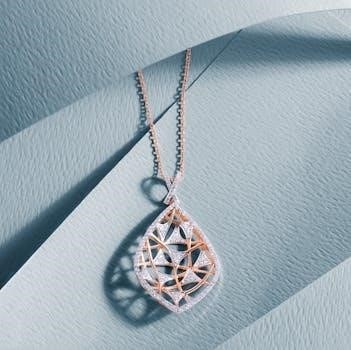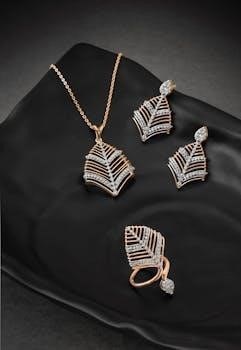Overview of “The Diamond Necklace”
Guy de Maupassant’s “The Diamond Necklace,” published in 1884, is a poignant short story. It centers on Mathilde Loisel, a woman longing for a luxurious life beyond her means. Her pursuit of social acceptance leads to a decade of hardship. The story explores themes of vanity and deceptive appearances.
Author and Publication Details
“The Diamond Necklace,” also known as “La Parure” in French, is a renowned short story penned by the esteemed French author, Guy de Maupassant. This tale, a hallmark of his literary style, first saw publication on February 17, 1884. It initially appeared in a French newspaper named Le Gaulois, captivating readers with its concise yet impactful narrative. Maupassant, a master of the short story form, skillfully crafted this piece within the genre of French naturalism, reflecting the social realities and complexities of 19th-century France. The story’s enduring popularity has led to its inclusion in numerous anthologies and translations across the globe. It is a significant example of his work, showcasing his talent for sharp observation and ironic twists. The story highlights the importance of understanding social dynamics and the human condition, establishing its position as a classic of French literature. His works are readily available in English, allowing a wider audience to appreciate his literary genius.
Brief Plot Summary
The narrative centers on Mathilde Loisel, a beautiful yet discontented woman married to a modest clerk. She yearns for a life of luxury and social status. When invited to a prestigious ball, she borrows a seemingly exquisite diamond necklace from her wealthy friend, Madame Forestier. At the event, Mathilde revels in the attention she receives, feeling her dreams of grandeur realized. However, disaster strikes when she loses the necklace. To replace it, she and her husband endure ten years of grueling poverty, working tirelessly to repay the debt incurred. The story culminates in a chance encounter with Madame Forestier, who reveals the original necklace was a mere imitation, worth far less than they had sacrificed for. This revelation underscores the tragic irony of their situation and the devastating consequences of vanity and materialistic desires. The story serves as a cautionary tale about the allure of appearances and the importance of appreciating what one has.

Character Analysis
This section delves into the key characters of the story. We will examine Mathilde’s desires and flaws. We also explore Monsieur Loisel’s contrasting nature. Their actions propel the narrative. This allows for a deeper understanding of the story’s message.
Mathilde Loisel’s Character
Mathilde Loisel is portrayed as a beautiful yet discontented woman, born into a modest family of clerks. Her beauty and charm fuel her yearning for a life of luxury and high society, a life that she believes she deserves. This internal conflict drives her actions throughout the story, leading to a series of choices motivated by vanity and a desire for social status. Mathilde’s dissatisfaction with her middle-class existence stems from a deep-seated feeling of inferiority. Her unhappiness is not rooted in genuine hardship but in her perception of what she lacks; Her character is defined by her preoccupation with appearances, and her desire to be admired by those in higher social circles. Mathilde’s initial vanity ultimately leads to a decade of suffering. Her journey highlights the dangers of valuing material possessions over genuine happiness, and it shows that appearances can be deceiving. Her character serves as a cautionary tale about the perils of unchecked ambition.
Monsieur Loisel’s Character
Monsieur Loisel is a stark contrast to his wife, Mathilde. He is a kind and devoted husband, content with his simple, middle-class life as a clerk in the Ministry of Education. He is portrayed as a practical and unassuming man, lacking the ambition and social aspirations that consume Mathilde. His love for Mathilde is evident in his willingness to go to great lengths to make her happy, even at his own expense. He is patient with her discontent, and he tries his best to satisfy her desires. His character is marked by his lack of vanity and his acceptance of his station in life. He is not driven by the same material desires as Mathilde. Monsieur Loisel’s actions are motivated by his love for Mathilde. He sacrifices his savings and works tirelessly to repay the debt incurred by the lost necklace. He epitomizes loyalty and selflessness. His character highlights the devastating consequences of Mathilde’s choices.

Themes and Literary Devices
“The Diamond Necklace” explores appearance versus reality, focusing on materialism and vanity. The necklace symbolizes false wealth, while irony and a twist ending highlight deception. These themes are central to the story’s impact.
Appearance vs. Reality
In “The Diamond Necklace,” the deceptive nature of appearances is a central theme, powerfully illustrated by the necklace itself. It seems to be a genuine, costly diamond necklace, yet it is merely an imitation, a piece of paste jewelry worth far less. This discrepancy highlights the core conflict of the story, between what things seem to be and what they actually are. Mathilde’s obsession with outward appearances leads her to believe that she needs expensive things to be happy, a fallacy that ultimately destroys her. The story shows how easily people can be deceived by surface impressions, emphasizing the importance of looking beyond the superficial. The dazzling appearance of the necklace masks its actual worth, paralleling Mathilde’s own life, which is outwardly respectable but inwardly unsatisfied. This theme reveals the dangers of valuing appearances over genuine qualities and the tragedy that can follow such misguided priorities. The irony of the situation is further enhanced by the contrast between the real and the perceived value of the necklace, and this discrepancy drives the narrative.
Materialism and Vanity
The story vividly portrays the dangers of unchecked materialism and vanity. Mathilde Loisel’s overwhelming desire for wealth and social status drives her actions and ultimately leads to her downfall. She believes that material possessions, such as the borrowed diamond necklace, will elevate her social standing and fulfill her happiness. This belief is a reflection of her deep-seated vanity and dissatisfaction with her current life. The story demonstrates how this obsession with material things clouds her judgment, preventing her from appreciating the simple, genuine aspects of her life. Her vanity is not just about wanting nice things; it’s about wanting the status and admiration she believes they bring. This focus on external validation makes her vulnerable to deception and causes her to make a series of unfortunate choices. The story serves as a cautionary tale, showing how the pursuit of material wealth and social recognition can lead to ruin and misery. The consequences of Mathilde’s materialism and vanity are severe and lasting, highlighting the destructive power of these traits.
Symbolism of the Necklace
The diamond necklace in Guy de Maupassant’s story is a powerful symbol with multiple layers of meaning. Initially, it represents the allure of wealth and the high society that Mathilde desires. It embodies her dreams of a life filled with luxury and admiration, a stark contrast to her own middle-class existence. The necklace is not just a beautiful object; it symbolizes the superficial values that dominate Mathilde’s world. It represents the deceptive nature of appearances, as it is later revealed to be an imitation, a fake. This revelation exposes the emptiness of Mathilde’s pursuit of material possessions and her misplaced focus on social status. It also symbolizes the heavy burden of debt and hardship that Mathilde and her husband endure to replace it, a burden built on an illusion. The necklace, in its glittering facade and ultimate worthlessness, is a metaphor for the deceptive nature of materialism and the tragic consequences of valuing appearances over substance. The necklace also symbolizes Mathilde’s vanity and her misplaced priorities.
Irony and Twist Ending
The story “The Diamond Necklace” is masterfully crafted around dramatic irony, where the reader is aware of information that the characters are not, especially Mathilde. She believes the necklace is genuine, leading her and her husband into years of backbreaking work and sacrifice to repay the debt incurred to replace it. This is ironic because the audience knows, or strongly suspects, that the borrowed necklace was not real diamonds. The twist ending reveals the ultimate irony⁚ the necklace was a cheap imitation, worth a fraction of what the Loisels paid. This final revelation not only provides a shocking twist but also underscores the futility of their suffering. The irony highlights the story’s central theme of appearance versus reality, exposing the deceptive nature of material possessions and the dangers of placing value on superficial things. The twist ending makes the story a cautionary tale, emphasizing the tragic consequences of vanity and misplaced priorities and the devastating impact of the pursuit of social status based on false pretenses. The twist is a trademark of Maupassant’s writing style.

Adaptations and Inspirations
“The Diamond Necklace” has seen various adaptations, including a 1975 radio play and a 2008 stage musical. It also inspired other works, like the short story “Paste.”
Radio and Stage Adaptations
“The Diamond Necklace” has resonated across different mediums, leading to several notable adaptations. A prominent example is the 1975 radio adaptation by George Lowther, episode 276 of the CBS Radio Mystery Theater series. This adaptation brought the story’s suspense and dramatic irony to life through sound, captivating audiences with its compelling narrative. The story has also found its way onto the stage, with the musical “Mathilde” composed by Conor Mitchell in 2008, as a testament to its timeless appeal and thematic depth. These adaptations demonstrate the story’s adaptability, proving its ability to maintain its impact across various forms of storytelling and connecting with audiences through different artistic expressions. Furthermore, the story has been interpreted in various cultural contexts, as demonstrated by its Sinhala translation, “Diyamanthi Maalaya,” highlighting its universal themes. The story’s transition from print to these audio and performance-based mediums indicates its lasting cultural significance.
Works Inspired by “The Necklace”
The narrative power of “The Necklace” extends beyond its direct adaptations, inspiring other creative works. One notable example is the short story “Paste,” written in 1899, which draws clear inspiration from Maupassant’s tale. This story reflects the influence of “The Necklace’s” exploration of deceptive appearances and the consequences of materialism. The themes of vanity and the pursuit of social status, so prominent in Maupassant’s work, continue to resonate with writers and artists. The enduring impact of “The Necklace” can be seen in the numerous creative pieces that have emerged, demonstrating its capacity to spark reflection on human desires and their often tragic outcomes. These works inspired by “The Necklace” serve as a testament to its lasting legacy, highlighting its continued relevance and its ability to capture the attention of new generations of storytellers who want to explore the themes that Maupassant so masterfully introduced.

Critical Analysis
This section will delve into the social commentary embedded within the story. We will examine the psychological aspects of the characters. The narrative perspective and its impact on the reader will be analyzed.
Social Commentary
“The Diamond Necklace” serves as a sharp critique of 19th-century French society, exposing its obsession with appearances and social status. Maupassant illustrates the rigid class structure and the yearning of the middle class to ascend the social ladder, even if it means falling into debt. Mathilde’s relentless pursuit of a life beyond her reach highlights the societal pressures to conform to superficial standards of wealth and beauty. The story emphasizes the dangers of valuing material possessions over genuine happiness and contentment. The narrative exposes the superficiality and the emptiness that can underlie the pursuit of a higher social standing. It is a cautionary tale about the destructive consequences of societal pressures and the illusion of happiness found in material wealth. The story critiques the social values that prioritize outward appearances over internal qualities and the damaging effect of such values. The story also portrays the hardships and sacrifices that people make in order to maintain a facade of wealth.
Psychological Aspects of Characters
The psychological aspects of the characters in “The Diamond Necklace” are central to understanding their motivations and actions. Mathilde Loisel is driven by a deep-seated inferiority complex and a craving for a life of luxury she believes she deserves. Her vanity and dissatisfaction with her middle-class existence consume her, leading her to prioritize superficial appearances over contentment. Her initial joy at the ball turns into despair when she loses the necklace, revealing her fragile emotional state. Monsieur Loisel, in contrast, embodies a more pragmatic nature. His love for Mathilde is evident in his willingness to sacrifice his own well-being to satisfy her desires. He is more accepting of their social standing, which contrasts with his wife’s restless ambition. His actions reveal a deep-rooted sense of duty and a quiet resignation to their circumstances. The story shows the effects of their individual psychologies on their marriage and their fates.
Narrative Perspective
Guy de Maupassant employs a third-person limited omniscient narrative perspective in “The Diamond Necklace,” which allows readers access to Mathilde Loisel’s thoughts and feelings, creating empathy for her plight, while also maintaining an objective distance. This perspective reveals her inner turmoil, her dissatisfaction with her life, and her yearning for a higher social status. It subtly exposes the flaws in her character, particularly her vanity and her focus on material possessions. The narrator guides the readers through her emotional journey, from excitement at the ball to despair after losing the necklace. This perspective allows the reader to understand Mathilde’s motivations. However, the narrator also presents events in a way that creates dramatic irony. The reader is privy to information that Mathilde lacks, particularly about the true value of the necklace. The narrator’s tone is generally detached, yet it subtly conveys a sense of social critique.

